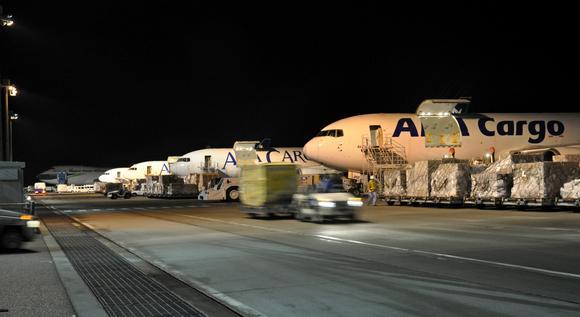“Okinawa.” The word so successfully brings about images of white beaches, vibrant culture, ancient castles and year-round good weather that this southernmost prefecture of Japan played host to nearly 7.2 million tourists in 2014.
While those tourists sleep, ANA Cargo’s overnight Okinawa Logistics Hub rumbles to life, connecting 12 nearby airports with each other via the airline’s 10 dedicated Boeing 767 freighters. “Naha Airport is strategically located for this sort of transhipment operation,” Takeshi Takahama told Asia Cargo News. “It’s the furthest airport from mainland Japan, and is much closer to many Asian destinations.”
Takahama, an ANA Cargo vice president who handles Okinawa sales and operations, says that the Okinawa hub aims to connect cities within about a four-hour flight radius – which includes nearly all of the major cities in eastern Asia, and from a population of some 2 billion people between Japan, China and the ASEAN countries. The hub serves four domestic destinations – Narita and Haneda international airports near Tokyo, Kansai International Airport near Osaka and Chubu Centrair International Airport near Nagoya – and eight international cities, including Seoul, Qingdao, Guangzhou, Shanghai, Hong Kong, Singapore, Bangkok and Taipei, with 126 weekly flights.
Each of the destinations was carefully chosen, Takahama says, not just for its location, but also for its ability to provide cargo passing through Okinawa with one-stop service to a host of other cities, including Kuala Lumpur, Hanoi, Macau, Phnom Penh and cities in mainland China.
Cargo bound for Europe and North America is typically routed through Narita, where it will travel as belly cargo on ANA passenger flights.
 Flights inbound to Okinawa depart their origin late at night, typically between 10 pm and midnight, which allows for most aircraft to arrive between 1:30 am and 3 am. Nearly all of the cargo aboard the inbound flights is for transhipment rather than being bound for Okinawa, and is quickly moved to its outbound aircraft. Controllers begin dispatching aircraft back to their origins shortly after 4 am, allowing for early-morning arrivals at destination airports. Naha Airport provides high-speed customs clearance 24 hours a day.
Flights inbound to Okinawa depart their origin late at night, typically between 10 pm and midnight, which allows for most aircraft to arrive between 1:30 am and 3 am. Nearly all of the cargo aboard the inbound flights is for transhipment rather than being bound for Okinawa, and is quickly moved to its outbound aircraft. Controllers begin dispatching aircraft back to their origins shortly after 4 am, allowing for early-morning arrivals at destination airports. Naha Airport provides high-speed customs clearance 24 hours a day.
Although Naha Airport is busy throughout the day with passenger arrivals – including ANA flights from 20 domestic cities – Takahama says that most of the belly cargo from those flights is bound for Okinawa. Nearly all of the Okinawa Logistics Hub work is done during the night, but the office is busy during the day preparing for the night ahead. “By operating on a 24-hour basis, we are able to reduce the lead time, which makes it possible to provide efficient, speedy transport not only through Asia but also on flights departing and arriving in rural Japan.”
Speedy and efficient transport is just what the hub was built for, he says, with much of the cargo being exports from Japan, including seafood; meat; produce including apples, peaches, mangos and rice; and processed foods.
“Japanese foods have a reputation for being clean, safe and delicious. The Ministry of Agriculture, Forestry and Fisheries of Japan [has been supportive of] the Okinawa hub as a way to increase Japan’s agricultural exports,” Takahama said.
The ministry reported in early 2015 that the export of Japanese agricultural, fishery and food products in 2014 hit a record high, increasing by 11.1% to ¥611.7 billion (US$4.98 billion), the highest figure since officials began keeping records in 1955. Hong Kong (¥134.3 billion), the United States (¥93.2 billion) and Taiwan (¥83.7 billion) were Japan’s top three export markets.
Machine parts and computers make up much of the inbound freight.
The hub might not exist were it not for the airline’s partnership with the Okinawa prefectural government, Takahama says. The government, he says, has invested some ¥7 billion (US$57 million) in the facility, which opened in 2009.
The government has continued to invest in the airport as a whole, including construction of a second 2,700 metre parallel runway on reclaimed land, which is expected to be completed in 2019 and a variety of improvements to and expansions of its passenger facilities. In 2011, it also opened a six-lane under-bay tunnel for auto and truck transport between the airport and Naha Port and between two nearby free trade zones.
By Gregory Glass
Asia Cargo News | Okinawa



